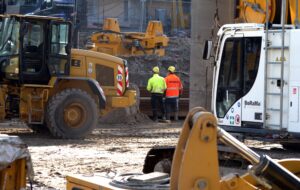
Ensuring Safety on the Construction Site: A Paramount Priority
In the bustling environment of a construction site, safety is not just a concern—it’s an absolute necessity. With a myriad of activities taking place simultaneously and numerous workers engaged in varied tasks, maintaining a secure and hazard-free environment is crucial.
The Cruciality of Safety
Safety on a construction site extends beyond mere compliance with regulations. It is inherently linked to the well-being of the workers, the reputation of the construction firm, and the successful and timely completion of the project. Worksite accidents or disruptions can lead to delays, and financial burdens, and, most significantly, can jeopardize the health and safety of the team.
Navigating the Risks and Implementing Precautions
The ripple effects of compromising safety on a construction site are multifaceted and profound, permeating through the legal, financial, and ethical realms of a project. A mishap due to overlooked safety protocols is not only a dire threat to worker welfare but can also escalate into severe financial and reputational consequences for the company involved.
The Ripple Effect of Neglected Safety Protocols
- Legal Repercussions: The legal framework surrounding construction safety is stringent, with non-compliance or negligence leading to hefty fines, sanctions, and potential legal actions against the company.
- Financial Setbacks: Accidents on-site can lead to unforeseen costs related to medical expenses, compensations, project delays, and sometimes, even resulting in an overall project halt, leading to monumental financial strains.
- Reputational Damage: News of an unsafe working environment or an accident can significantly tarnish a company’s reputation, deterring potential clients and dissuading top talent from associating with such an entity.
- Moral and Ethical Implications: Above all, ensuring the physical well-being and security of workers is a moral obligation. No profit margin or project deadline should supersede the paramountcy of life and limb.

Evaluating Job Site Safety: A Proactive Approach
The adage “Prevention is better than cure” holds immense weight in managing construction site safety. A thorough and regular evaluation of the entire jobsite for potential safety concerns is imperative to preemptively address issues before they burgeon into serious threats. Here’s a structured approach towards evaluating jobsite safety:
- Risk Assessment: Conduct a thorough risk assessment of the entire jobsite, identifying potential hazards, such as fall risks, unstable structures, electrical dangers, and any other site-specific threats.
- Safety Audits: Regular safety audits, conducted by internal safety officers or external experts, can ensure that the identified risks are adequately mitigated and that all safety protocols are being adhered to diligently.
- Worker Feedback: Engaging with workers to obtain feedback about potential safety concerns can also unearth overlooked or unnoticed hazards. Workers, being directly engaged in the operations, can provide insights that might be missed during formal audits.
- Continuous Monitoring: Employ technology, like surveillance cameras and wearable tech, to continuously monitor safety compliance on site, enabling real-time intervention in case of any safety breaches.
- Emergency Preparedness: Ensure that the site is equipped to handle emergencies effectively. This includes having an emergency response plan, evacuation routes, and necessary emergency response equipment readily available and in optimal working condition.
Understanding the critical risks and implementing a structured, proactive approach to ensuring safety on the construction site reflects not just regulatory compliance but also embodies the ethical responsibility of a company towards its workforce. A seamless amalgamation of robust safety protocols, regular evaluations, and a tangible commitment towards worker safety will pave the way towards establishing a culture that values life, health, and wholesome working environments above all.
Upholding Safety through Licensing and Certifications
A paramount aspect of ensuring a steadfast adherence to safety on a construction site is the scrupulous management and update of all pertinent licenses and certifications. Not only does this adherence to legalities demonstrate a company’s commitment to official regulations and standards, but it also illustrates an intrinsic value for safety and expertise within the organization.
The Significance of Proper Licensing
Licensing, in the realm of construction, typically involves a detailed validation of a company or contractor’s capability to perform specific types of work, ensuring they possess the necessary skills and knowledge to navigate through construction projects safely and efficiently. This validation often requires passing exams that scrutinize technical know-how, and possibly, a review of previous work.
- Validity and Credibility: Holding the correct licenses demonstrates a basic competency in relevant skills and adherence to local and state regulations, therefore bolstering the credibility of the company.
- Legal Repercussions: Engaging in construction activities without the necessary licenses can lead to hefty fines, legal actions, and a potential halt in operations, negatively impacting both finances and reputation.

Importance of Individual and Team Certifications
While licensing typically pertains to the company or specific contractors, certifications often apply to individual professionals within the team, signifying their expertise and knowledge in particular areas.
- Enhanced Safety: Workers who have undergone thorough training and certification are typically more adept at identifying and mitigating potential risks, enhancing overall site safety.
- Quality Assurance: Certifications can often be seen as a marker of quality, ensuring that the work is performed to a particular industry standard.
- Competitive Edge: Certified professionals not only enhance the quality and safety of the work but also provide a competitive advantage in the marketplace.
Staying Compliant: A Continuous Effort
Compliance with licensing and certification requirements is not a “set and forget” endeavor but requires continuous attention and management.
- Regular Audits: Conduct regular audits of all licenses and certifications held by the company and the team, ensuring that they are valid and up-to-date.
- Continual Training: Engage the team in continuous training programs that keep them abreast of the latest industry practices and prepare them for recertification exams.
- Legal Updates: Keep a vigilant eye on any changes in local, state, or federal regulations that may necessitate additional licenses or alter existing requirements.
- Documentation: Maintain meticulous documentation of all licenses, certifications, and training sessions, ensuring that records are accurate, current, and readily accessible.
The meticulous management of licenses and certifications is not only legally obligatory but also serves to enhance the safety, quality, and reputation of a construction firm. In an industry where risks are ever-present, being thorough and proactive in upholding safety through proper licensing and certifications serves as a bedrock upon which safe and efficient operations can be built. This diligence, in turn, reflects positively on the company, strengthening both its internal operations and its standing in the competitive market.
Implementing Safety Protocols
Establishing comprehensive safety protocols involves regular safety training sessions, adherence to guidelines, and availability of safety gear. These components should work in tandem to create a coherent, highly-regarded safety culture within the construction site. Regular toolbox talks, safety drills, and clear communication about potential hazards can further solidify this culture among all onsite personnel.
Embarking on the journey of implementing comprehensive safety protocols necessitates a meticulous and systematic approach. Prioritizing and ensuring safety, especially in an industry rife with potential hazards like construction, is pivotal.

Step 1: Develop a Comprehensive Safety Plan
Craft a detailed safety plan that encompasses all possible aspects of on-site work and potential risks associated with each task. This plan should act as a guide, outlining protocols, emergency procedures, and risk mitigation strategies pertinent to each identified hazard.
Step 2: Safety Training for All Personnel
Training is the cornerstone of ensuring that safety protocols are not only in place but are also effectively adhered to. Regular, thorough training sessions should be mandatory for all personnel, ensuring they are well-versed with the safety plan, emergency procedures, and the usage of safety equipment.
Step 3: Designate Safety Officers
Assign or hire qualified safety officers responsible for overseeing the adherence to safety protocols, conducting regular site inspections, and spearheading safety training sessions. Their primary role will be to ensure that safety is seamlessly woven into the daily operations on the jobsite.
Step 4: Regular Safety Audits
Employ a systematic schedule for safety audits, ensuring that the implemented safety measures are consistently adhered to and remain effective. Safety audits also serve to identify potential loopholes or newly emerged risks on the jobsite, allowing for timely interventions.
Step 5: Establish a Reporting System
Implement a clear, straightforward reporting system that allows workers to promptly report safety concerns or incidents. A transparent and easily navigable system encourages workers to communicate issues without fear of reprisals, facilitating a quicker resolution to emerging safety concerns.
Step 6: Continual Improvement and Adaptation
Adopt a mindset of continuous improvement regarding safety protocols. Regularly reassess and adapt safety plans to accommodate any changes or additions to the jobsite, ensuring that the safety protocols evolve parallelly with the progress and dynamics of the construction project.
Implementing safety protocols extends far beyond mere compliance with regulatory standards. It reflects a company’s commitment to safeguarding its workforce, thereby fostering a culture that prioritizes well-being and cultivates a secure and protective working environment. Moreover, a tangible commitment to safety also positively impacts a company’s reputation, client trust, and overall operational efficiency by mitigating potential disruptions due to safety incidents.

Role of On-Site Office Space in Enhancing Safety
Enter the pivotal role of an on-site office space, such as a construction office trailer. A dedicated space directly on the construction site is instrumental in several key aspects of maintaining and enhancing safety protocols:
- Safety Trainings: A mobile office trailer provides an ideal, distraction-free environment to conduct vital safety training sessions, workshops, and briefings. This secluded space allows for focused learning and interaction, ensuring that safety norms are understood and retained by the workers.
- Storage of Safety Gear: Safety gear, such as helmets, vests, goggles, and gloves, is pivotal to ensuring the physical safety of workers. A mobile office trailer can serve as a centralized storage unit for all safety equipment, ensuring that it is easily accessible, well-maintained, and not exposed to the external elements when not in use.
- First Aid Station: In the unfortunate event of an accident or injury on-site, immediate first aid can be a lifesaver. Equipping a section of the mobile office trailer as a first-aid station ensures that preliminary medical care is promptly available in case of emergencies.
- Documentation and Compliance: Ensuring that all safety compliances and records are meticulously documented is essential for legal and regulatory adherence. A mobile office trailer can securely store all relevant documentation, permits, and records, safeguarding them from potential damage at the worksite.
Navigating Through the Layers of Regulatory Compliance
Compliance with local, state, and federal safety regulations is paramount in ensuring that a construction site adheres to standardized safety protocols, thereby safeguarding the well-being of its workers. Navigating through these layers of regulatory compliance necessitates a profound understanding of the applicable laws and guidelines pertaining to construction safety.
Keeping Abreast of Changing Safety Regulations
In an industry that continually evolves, staying updated with the latest safety regulations is crucial. Regulatory bodies may introduce new guidelines or amend existing ones to reflect the current best practices and learnings from the industry. Regularly reviewing these regulations and ensuring that the practices on your construction site are in alignment is pivotal to maintaining a safety-compliant environment.
Training and Certification
Ensuring that your team is well-versed with the prevalent safety regulations and is adequately trained to implement them is another crucial aspect. This involves organizing periodic training sessions and encouraging certifications that enhance the knowledge and expertise of your crew in managing and ensuring safety on-site. This not only empowers your team but also ensures that safety is a collective responsibility embraced by all.
Safety Audits and Inspections
Conducting regular safety audits and inspections is a proactive measure to ascertain that all safety protocols are being adhered to and to identify potential hazards before they culminate into tangible risks. This involves a systematic examination of the jobsite, scrutinizing the equipment, evaluating the work practices, and ensuring that every operational facet aligns with the stipulated safety guidelines.
Incident Reporting and Analysis
In the unfortunate event of a safety incident, having a robust incident reporting and analysis mechanism is vital. This involves documenting the incident meticulously, analyzing the causative factors, and implementing corrective measures to prevent the recurrence of such incidents. An open and transparent communication channel that encourages workers to report incidents and hazards without fear of retribution is crucial in fostering a safety-centric culture.

Cultivating a Safety-first Culture
Establishing a safety-first culture goes beyond compliance and enters the realm of collective responsibility. This involves creating an environment where each individual on the jobsite prioritizes safety, not just as a compliance requirement, but as an inherent practice. Regular safety talks, recognitions, and encouraging safety suggestions are ways through which a safety-first culture can be cultivated.
Ensuring safety on the construction site is a multifaceted endeavor that intertwines regulatory compliance, active risk management, collective responsibility, and a proactive approach towards identifying and mitigating potential hazards. As the construction processes evolve, adapting and enhancing safety practices to align with the dynamic environment ensures that the well-being of the personnel is perennially safeguarded, reflecting not just compliance but a genuine commitment to safety.
Integrating Safety and Productivity
While an unwavering focus on safety is non-negotiable, it also indirectly propels productivity by ensuring that work progresses without hazardous interruptions. Workers, assured of their safety and well-being, are likely to be more focused and productive. Ensuring safety on the construction site is not just a regulatory requirement but a moral and financial imperative.
While we’ve navigated through the vital landscapes of safety protocols, certifications, and licensing, it’s pivotal to recognize that ensuring safety is an ongoing process. Should you find that a mobile office trailer fits into your safety and operational strategy, we at Office Trailer Sales stand ready to assist. From providing a secure space for safety training and documentation storage to creating a designated area for safety equipment, our range of mobile office trailers can be tailored to meet the unique demands of your construction site.

Leave a Reply